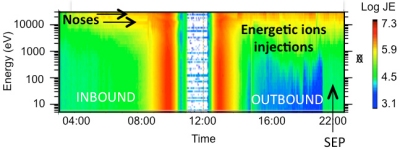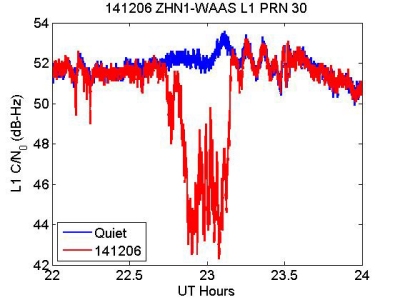Monitoring the impact of extreme solar events
29 April 2009
Combined observations with six spacecraft have allowed scientists to monitor in detail the impact of extreme solar events on the Earth. The study, based on data from four Cluster and two Double Star spacecraft, demonstrated that the typical ion composition observed in the near-Earth environment was drastically modified by extreme solar events and that the magnetosphere became extremely compressed. In situ observations of such changes provide vital information for models of our near-Earth environment where commercial and military spacecraft orbit.| Movie 1. X-3 solar flare observed on 13 December 2006. Credit: SOHO ESA/NASA |
More generally, the electronic components, onboard memory and cameras on board satellites can be greatly affected by extreme solar events. Developing the ability to accurately forecast the impact and effect of solar explosions (Movie 1) on the near-Earth environment is thus becoming more and more critical to our daily life. This can be done by precisely estimating the key physical parameters of the near-Earth environment and their time evolution, and using this information to constrain models.
A recent paper by Iannis Dandouras and colleagues reports the analysis of two extreme solar events that occurred on 21 January 2005 and 13 December 2006 where the four Cluster (ESA/NASA) and the two Double Star (CNSA/ESA) spacecraft were favourably positioned to provide coordinated measurements of the response of the magnetosphere to these events.
From measurements obtained with both sets of spacecraft, the speed of positively charged particles (or ions) in the solar wind was found to be more than 900 kms-1, more than twice their normal speed. The high speed flow was accompanied with a jump in the ion density by a factor of 5 and a dramatic change of ionic composition (for the 21 January 2005 event). This resulted in an unusual compression of the magnetosphere.
Cluster and Double Star data indicate that the 'nose' of the dayside magnetopause, usually located at an altitude of around 60 000 km, was only 25 000 km from Earth during these extreme solar events.
The second solar event was associated with an X-3 solar flare on 13 December 2006 which was followed by a Coronal Mass Ejection. This event was directly associated with the loss of GPS signal reception on the ground (Figure 1).
In near-Earth space, the typical "nose-like" ion structures were "washed out" by several successive injections of energetic particles (Figure 2). These ion structures were previously formed in an equatorial region of the near-Earth environment called the ring current. This region plays a critical role in satellite safety. The Cluster and Double Star spacecraft simultaneously detected these ion structures on opposite sides of Earth, thus providing information on their large-scale structure and dynamics. These injections resulted in a much harder ring current energy spectrum (see Figure 2).
About 5 hours after the impact of the Coronal Mass Ejection on the Earth's magnetosphere, the Double Star spacecraft TC-1 recorded the presence of penetrating Solar Energetic Particles (SEP) on the nightside (these appear as a green haze on Figure 2). These particles can be a serious hazard to spacecraft electronics and to astronauts.
"All the detailed information gathered on these extreme solar events helps to constrain computer models of the inner magnetosphere and the near-Earth environment," says Dr. Iannis Dandouras, lead author of the report and Principal Investigator of the Cluster Ion Spectrometer (CIS) instrument on Cluster.
"Looking at such a large scale physical phenomenon with a single spacecraft is something akin to predicting the location of the impact of a tsunami with a single buoy. Cluster and Double Star have once again demonstrated the value in coordinated multipoint plasma measurements in space, this time by monitoring the impact of Coronal Mass Ejections on both sides of Earth," comments Matt Taylor, acting ESA project scientist of the Cluster and the Double Star missions.
 |
| Figure 2. Double Star TC-1 ion data recorded on December 14, 2006 near perigee. Credit: I. Dandouras/ESA |
Reference publication
Dandouras, I.S., Rème, H., Cao, J., Escoubet, P., Magnetosphere response to the 2005 and 2006 extreme solar events as observed by the Cluster and Double Star spacecraft, Advances in Space Research, Vol.43, pp. 618–623, 2009, doi:10.1016/j.asr.2008.10.015
Related publication
Dandouras, I., J. Cao, and C. Vallat (2009), Energetic ion dynamics of the inner magnetosphere revealed in coordinated Cluster-Double Star observations, J. Geophys. Res., 114, A01S90, doi:10.1029/2007JA012757
Contact
Iannis Dandouras, CESR, Université de Toulouse/CNRS, 9 Avenue du Colonel Roche, Toulouse, France.
Email: iannis.dandouras cesr.fr, phone: +33561558320
cesr.fr, phone: +33561558320
Web story author and co-editor
Arnaud Masson, Science and Robotic Exploration Directorate, ESA, The Netherlands.
Email: Arnaud.Masson esa.int, phone: +31-71-565-5634
esa.int, phone: +31-71-565-5634
Web story editors
Matt Taylor, Science and Robotic Exploration Directorate, ESA, The Netherlands.
Email: Matthew.Taylor esa.int, phone: +31-71-565-8009
esa.int, phone: +31-71-565-8009
Philippe Escoubet, Science and Robotic Exploration Directorate, ESA, The Netherlands.
Email: Philippe.Escoubet esa.int, phone: +31-71-565-4564
esa.int, phone: +31-71-565-4564




